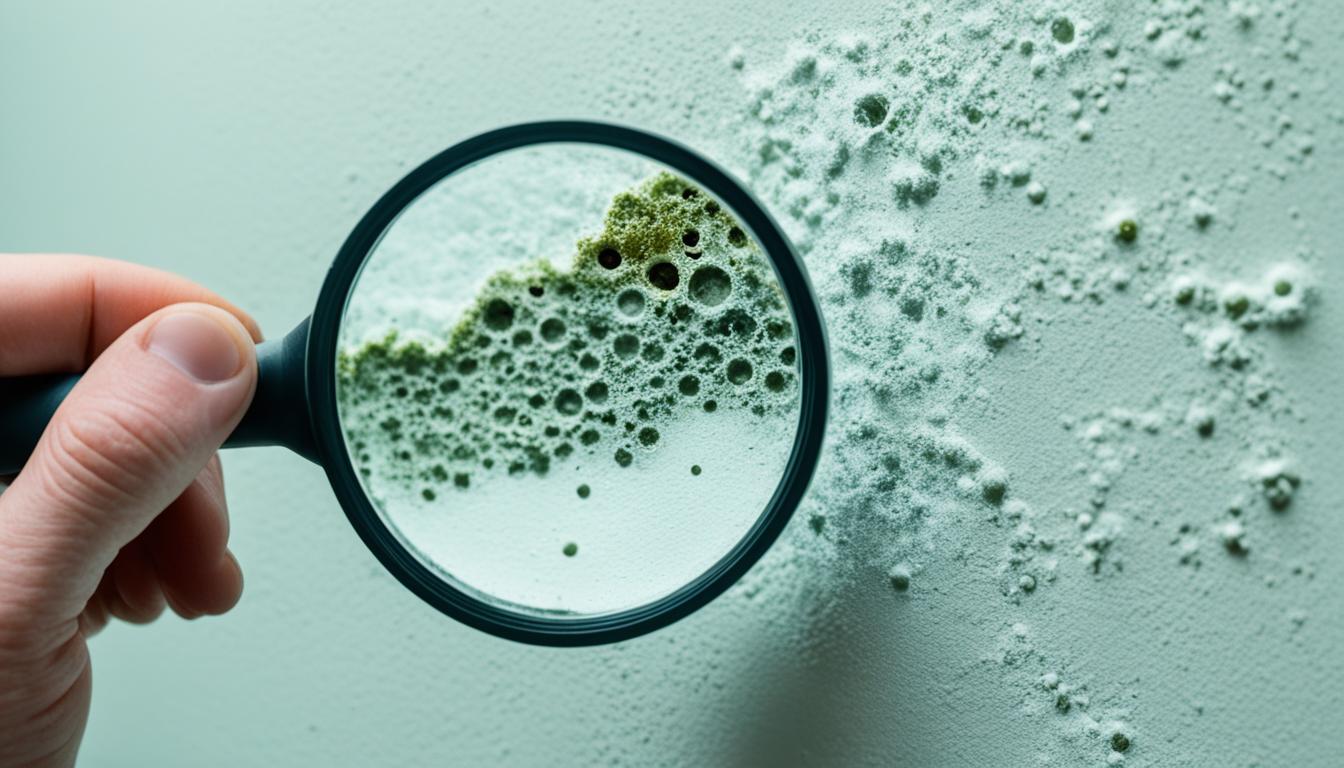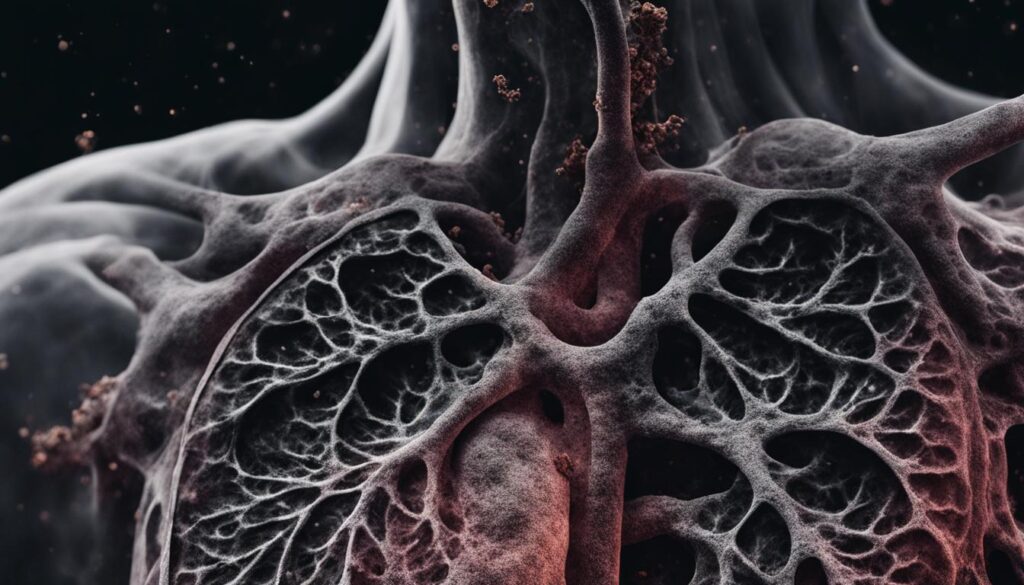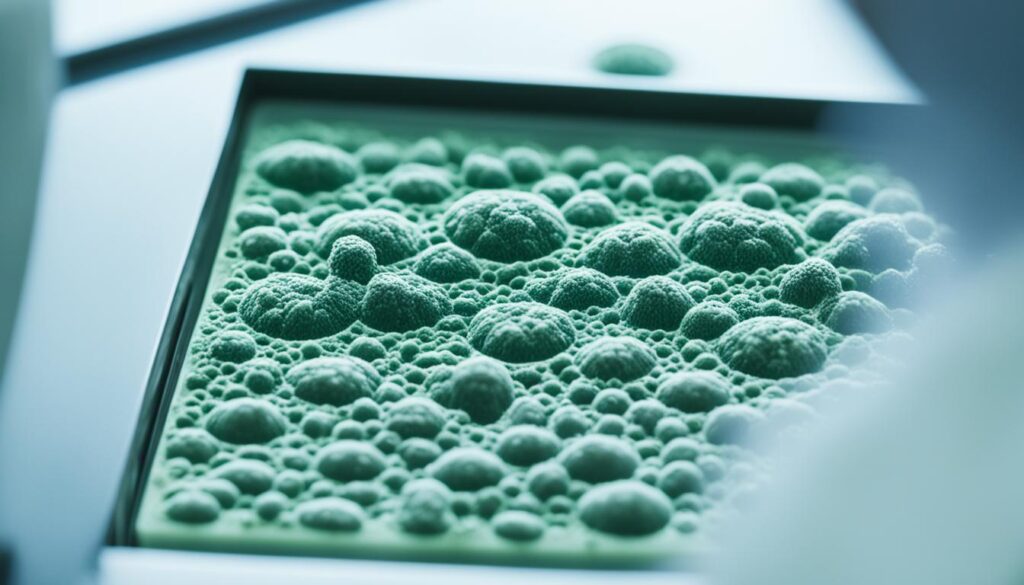
Is Most Mold Harmless? Facts on Mold Safety
Welcome to our comprehensive guide on mold safety. In this article, we will address the common question of whether most mold is harmless and provide crucial information on mold safety and the health effects of mold exposure. Mold is a common issue in homes and buildings, and understanding its potential risks is essential for maintaining a healthy environment. Let’s dive in and explore the facts about mold safety.
Key Takeaways:
- Most mold is not harmless and can have adverse effects on your health.
- Mold exposure can lead to allergies, respiratory issues, and skin irritation.
- Early detection and proper identification are crucial to addressing mold problems.
- Prevention strategies and professional mold remediation are essential for safe mold removal.
- Consider mold testing options and consult professionals for accurate assessments.
Understanding Mold: Common Types and Identification
When it comes to mold, understanding the different types and knowing how to identify them is crucial for maintaining a safe and healthy indoor environment. Mold can be found in various places, such as homes, offices, and public buildings, and it is essential to be able to recognize its presence early on.
Common Types of Mold
There are several common types of mold that are frequently encountered in indoor environments:
- Stachybotrys chartarum (black mold): This type of mold is typically greenish-black in color and has a slimy texture. It often thrives in areas with high levels of moisture and can cause severe health issues.
- Aspergillus: Aspergillus mold is commonly found in damp and humid environments, such as bathrooms and basements. It can appear in various colors, including green, brown, or yellow.
- Penicillium: Penicillium mold is commonly found indoors and can grow on a wide range of materials, including food, wallpaper, and carpet. It often appears blue or green.
- Cladosporium: Cladosporium mold is typically dark-colored and can be found in both warm and cold environments. It commonly grows on damp surfaces, such as carpets and wallpaper.
These are just a few examples of the common types of mold that can be found in indoor spaces. It is important to note that mold can come in various colors and textures, and professional assessment may be necessary to accurately identify specific types.
Identification of Mold
Identifying mold growth in your home or building is essential for taking appropriate action. Here are some key indicators to look out for:
- Visual signs: Mold growth is often visible on surfaces, appearing as patches or discoloration. It can be fuzzy, slimy, or powdery in texture, depending on the type of mold.
- Musty odor: Mold emits a distinct musty smell, which can be an indicator of its presence even if no visible mold is apparent.
- Allergies and respiratory symptoms: If you or others in the space experience unexplained allergies, coughing, or respiratory issues, it could be a sign of mold growth.
Early detection is key to addressing mold issues promptly and preventing further damage. If you suspect mold growth in your home or building, it is advisable to seek professional assistance for proper identification and remediation.
Remember, identifying and addressing mold promptly is crucial for maintaining a healthy indoor environment. Stay vigilant and prioritize the well-being of your space and those who occupy it.
Health Effects of Mold Exposure
Exposure to mold can have various health effects, ranging from mild allergies to more severe respiratory and skin conditions. It is vital to be aware of these potential risks to take proper precautions and address mold issues promptly.
Common Symptoms
Mold exposure can cause a range of symptoms, including:
- Allergic reactions, such as sneezing, coughing, and watery eyes
- Respiratory issues, like wheezing, shortness of breath, and chest tightness
- Skin irritation, such as rashes, itching, and redness
These symptoms may vary in intensity depending on the individual’s sensitivity to mold and the duration of exposure.
Potential Severe Health Conditions
Extended exposure to specific types of mold can lead to more severe health conditions, especially for individuals with compromised immune systems or pre-existing respiratory conditions. Some of these conditions include:
- Asthma exacerbation: Mold spores can trigger asthma attacks or worsen existing asthma symptoms.
- Allergic bronchopulmonary aspergillosis (ABPA): This is a hypersensitivity lung disease caused by an allergic reaction to mold spores.
- Fungal infections: Certain molds, such as Aspergillus and Stachybotrys, can cause fungal infections in the lungs or other parts of the body.
It is essential to consult with a healthcare professional if you suspect mold exposure-related health issues to receive appropriate diagnosis and treatment.
Protecting Your Health
To minimize the health risks associated with mold exposure, consider the following preventive measures:
- Control indoor humidity levels below 50% to discourage mold growth.
- Repair any water leaks or moisture issues promptly.
- Ensure adequate ventilation in bathrooms, kitchens, and other areas prone to moisture accumulation.
- Clean and dry water-damaged materials within 48 hours to prevent mold growth.
- Use air purifiers and dehumidifiers to improve indoor air quality.
- If you notice visible mold growth or experience unexplained health symptoms, seek professional assistance for proper mold assessment and remediation.
Remember, proactive steps to prevent and address mold issues are crucial for maintaining a safe and healthy indoor environment.

Removing Mold Safely: Prevention and Remediation
When it comes to mold, taking prompt action is crucial to protect your health and property. In this section, we will provide you with essential tips and guidelines for removing mold safely from your homes and buildings. We will also cover preventive strategies to minimize the risk of mold growth and discuss the step-by-step mold remediation process. Remember, for extensive mold problems, it is important to hire professionals with expertise in mold assessment and remediation.
Taking Steps to Prevent Mold Growth
Prevention is key when it comes to dealing with mold. By being proactive and implementing the following preventive measures, you can significantly reduce the chances of mold growth in your living or working spaces:
- Control indoor humidity levels: Keep your indoor humidity levels below 50% to discourage mold growth. You can use dehumidifiers to help maintain optimal humidity levels.
- Repair leaks promptly: Address any leaks or water damage as soon as possible. Mold can start growing within 24-48 hours of water exposure.
- Improve ventilation: Proper airflow helps to prevent humidity buildup and mold growth. Ensure that your bathrooms, kitchens, and laundry areas are adequately ventilated.
- Use mold-resistant materials: When renovating or building, opt for mold-resistant building materials. These materials are designed to inhibit mold growth.
- Keep your space clean: Regularly clean your living or working spaces to remove dust and dirt that can contribute to mold growth.
The Mold Remediation Process
If you have discovered mold growth in your home or building, it is important to initiate the mold remediation process promptly. Let’s go through the crucial steps involved:
- Assessment: Hire a professional mold assessment service to identify the extent of the mold problem and determine the appropriate remediation plan.
- Containment: Establish proper containment measures to prevent the spread of mold spores during the removal process. This may involve sealing off affected areas and using containment barriers.
- Removal: Carefully remove and dispose of mold-infested materials, following industry best practices and safety guidelines. Personal protective equipment should be worn to minimize exposure to mold spores.
- Cleaning: Thoroughly clean the affected areas using specialized mold cleaning solutions and techniques to ensure complete mold removal.
- Drying and Dehumidification: Completely dry the affected areas and address any underlying moisture issues to prevent future mold growth.
- Verification: After remediation, hire a mold assessment service to perform post-remediation verification to ensure that the mold problem has been effectively resolved.
By following these steps and seeking professional guidance, you can effectively remove mold from your living or working spaces and restore a safe and healthy environment.
| Benefits of Professional Mold Remediation | DIY Mold Remediation |
|---|---|
|
|
Mold Testing: Options and Considerations
When it comes to mold, early detection is key to preventing extensive damage and ensuring the safety of your home and its occupants. Mold testing is a crucial step in identifying and addressing mold growth. In this section, we will explore the different options available for mold testing and provide guidance on when and why it may be necessary.
The Pros and Cons of DIY Mold Testing Kits
DIY mold testing kits have gained popularity due to their convenience and affordability. These kits typically involve collecting samples using swabs or air cassettes and sending them to a lab for analysis. While DIY testing kits can provide some level of insight into the presence of mold, they have their limitations.
“DIY mold testing kits can be a useful initial step in identifying potential mold issues, but they may not provide accurate and comprehensive results.”
One of the main drawbacks of DIY testing kits is the risk of incorrect sampling. Improper collection techniques can lead to inaccurate results, potentially underestimating or misidentifying the extent of mold growth. Additionally, DIY kits may not detect certain types of mold or provide information on the underlying causes of the mold growth.
Professional Mold Assessments: A Comprehensive Solution
For a more thorough and accurate assessment of mold growth, professional mold assessments are recommended. Certified mold inspectors have the expertise and specialized equipment necessary to conduct comprehensive inspections and testing.
“Professional mold assessments offer a comprehensive and reliable approach to identifying mold issues, determining the extent of the problem, and recommending appropriate remediation strategies.”
During a professional mold assessment, inspectors will conduct visual inspections, collect samples for laboratory analysis, measure moisture levels, and assess potential sources of mold growth. The results of these assessments are often more reliable and insightful than those obtained through DIY testing kits.
When Should You Consider Mold Testing?
While DIY testing kits can be used to perform preliminary checks for mold growth, there are certain situations where professional mold testing is highly recommended. These include:
- Visible signs of mold or a musty odor in your property
- Unexplained symptoms such as allergies, respiratory issues, or skin irritation
- Water leaks, flooding, or moisture problems in the past
- Prior mold remediation efforts to ensure the effectiveness of the treatment
By considering these factors and consulting with a mold remediation expert, you can make an informed decision on whether mold testing is necessary in your specific situation.

Pros and Cons of Mold Testing Options
| Testing Option | Pros | Cons |
|---|---|---|
| DIY Mold Testing Kits | – Convenient and affordable – Can provide initial insight into mold presence – Suitable for preliminary checks |
– Risk of incorrect sampling – Limited accuracy and comprehensiveness – May not detect all types of mold or provide underlying causes |
| Professional Mold Assessments | – Comprehensive and reliable – Conducted by certified experts – Thorough inspections and testing – Insightful results and recommendations |
– Higher cost compared to DIY kits – Requires scheduling and coordination with professionals |
As shown in the table above, both DIY mold testing kits and professional mold assessments have their advantages and drawbacks. It is important to consider your specific needs, budget, and the level of accuracy required when deciding on the best option for mold testing.
Fix Mold Miami: Florida’s Mold Assessment Experts
Welcome to Fix Mold Miami, the leading provider of mold assessment, prevention, and remediation services in Florida. With our expert team and extensive experience, we are committed to ensuring safe and healthy indoor environments for our clients.
At Fix Mold Miami, we understand the potential dangers and health risks associated with mold growth. That’s why we offer comprehensive mold assessment services to identify and evaluate the extent of mold contamination in residential and commercial properties.
Our skilled mold assessment experts utilize advanced techniques and state-of-the-art equipment to conduct thorough inspections. We assess the air quality, visually inspect affected areas, and collect samples for laboratory analysis. This meticulous approach allows us to provide accurate and reliable reports on the presence and severity of mold infestations.
Once the assessment is complete, our team will work closely with you to devise an effective mold prevention and remediation plan. We prioritize the safety and well-being of our clients, implementing industry best practices and adhering to all relevant regulations.
Fix Mold Miami offers a range of services to address mold issues, including mold removal, remediation coordination, and preventative measures to mitigate the risk of future mold growth. Our team of experts is dedicated to restoring healthy indoor environments and providing peace of mind to our clients.
If you suspect mold growth in your property or are concerned about indoor air quality, contact Fix Mold Miami today at 305-465-6653 to schedule a mold assessment. Our knowledgeable team is ready to assist you and ensure that your property is free from the health hazards associated with mold.
| Why Choose Fix Mold Miami? | Our Services |
|---|---|
|
|
|
|
|
|
|
|
|
|
|
|
Conclusion
In conclusion, while most mold may seem harmless, it is important to understand the potential health effects associated with mold exposure. Mold can trigger allergies, respiratory issues, and skin irritation in individuals. Prolonged exposure to certain types of mold may even lead to more severe health conditions.
Proper identification and proactive measures are crucial in preventing and addressing mold issues. Early detection and prompt remediation can help minimize the risk of health problems and costly damages to your property. It is advisable to consult professionals, such as Fix Mold Miami, to ensure effective and safe mold assessment, prevention, and remediation.
Remember, taking mold safety seriously and implementing preventive measures can help create a healthy indoor environment for you and your family. Don’t underestimate the potential harm that mold can cause. Stay informed and take action to protect your well-being.




